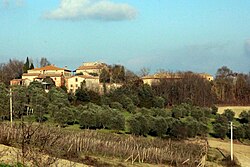
The Crete Senesi refers to an area of the Italian region of Tuscany immediately to the south of Siena. It consists of a range of hills and woods among villages and includes the comuni of Asciano, Buonconvento, Monteroni d'Arbia, Rapolano Terme and San Giovanni d'Asso, all within the province of Siena. They border to the north with the Chianti Senese area, to the east with Val di Chiana and to the south-west with Val d'Orcia. Nearby is also the semi-arid area known as the Accona Desert.

The province of Siena is a province in Tuscany, Italy. Its capital is the city of Siena.

Asciano is a comune and hill town in the province of Siena in the Italian region Tuscany. It is located at the centre of the Crete senesi between the river Ombrone and the torrent Copra, some 30 kilometres (19 mi) southeast of the town of Siena by rail.

Trequanda is a comune (municipality) in the Province of Siena in the Italian region Tuscany, located about 70 kilometres (43 mi) southeast of Florence and about 30 kilometres (19 mi) southeast of Siena.
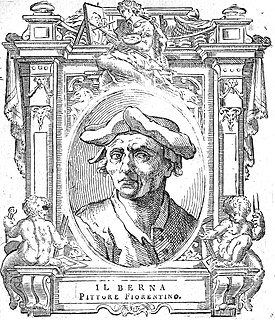
Barna da Siena, also known as Berna di Siena, was presumed to be a Sienese painter active from about 1330 to 1350.

Amos Cassiòli was an Italian painter, of battle scenes, historical canvases and portraits. He worked in a Purismo style.
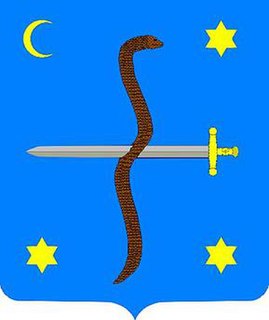
The Vegni are an Italian family from Siena. The medioeval origins of the family have limited documentation. The origin of the family is in Siena, with Bencivenne, father of Aringhieri, whose children Guido, Iacobina and Ranieri are mentioned in a contract of a house sale in 1201. The son of Guido, Bencivenni, is the first one to have a recognised profession mentioned in the documents. A notary of the royal chamber, called Bencivennis olim Guidi, was active in Siena in the first part of the 13th century. The patronymic Bencivennis is used, abbreviated as bcVennis in the documents signed by Luca, a notary, in documents he drew up during late 13th. Pietro olim (of) Luca bcVennis was active in Siena until 1321. The sons of Pietro settled in the area of Chianciano, focusing the centre of interests of the family in the South of the Siena Republic until the fall of it in 1555. The surname Bencivennis remains in official documents during all the Republican period, to disappear at the end of the 16th century, substituted by Vegni. The last one to use it in official documents is Eustachio Bencivennis or bcVegnis, again a notary, who died in 1585. His grandson Giovanni Battista di Pietro, a notary in Chianciano between 1600 and 1641, signs his documents as Vegni, although he still uses the same private legal seal with the family coat of arms.

Accona desert refers to a hilly area in the Siena province of Italy, within the municipality of Asciano [43°14'4.30"N; 11°33'37.48"E] often enlarged to include the biancana site of Le Fiorentine - Leonina [ 43°17'32.95”N; 11°26'54.07"E]. The term desert is inappropriate from a physical and climatic point of view, rather the climate is Mediterranean with a hot dry summer and almost 800 mm/y of rain. A real desert has never existed here, unless “desert” was a way of describing severely eroded areas, more properly called “badlands”, even if temporary ones.

The Master of the Osservanza Triptych, also known as the Osservanza Master and as the Master of Osservanza, is the name given to an Italian painter of the Sienese School active about 1430 to 1450.

Siena railway station serves the city and comune of Siena, in the region of Tuscany, central Italy. Opened in 1935, it is the terminus of the lines to Empoli, to Chiusi and to Grosseto via Monte Antico.

The Ferrovia Asciano–Monte Antico is a railway line linking the town of Asciano to Monte Antico in the municipality of Civitella Paganico in Southern Tuscany.

San Bernardino is a Romanesque-style, former Roman Catholic church building, for some decades converted to museum, in the town of Asciano, Province of Siena, region of Tuscany, Italy.
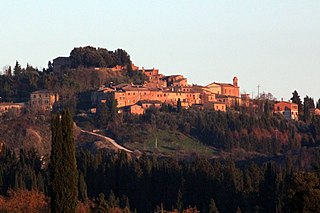
Chiusure is a village in Tuscany, central Italy, administratively a frazione of the comune of Asciano, province of Siena. At the time of the 2001 census its population was 115.

Arbia is a town in Tuscany, central Italy, administratively a frazione of the comune of Asciano, province of Siena. At the time of the 2001 census its population was 1,303.

Castelnuovo Scalo is a village in Tuscany, central Italy, administratively a frazione of the comuni of Asciano and Castelnuovo Berardenga, province of Siena. At the time of the 2001 census its population was 73.
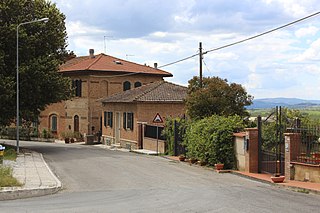
Torre a Castello is a village in Tuscany, central Italy, administratively a frazione of the comune of Asciano, province of Siena. At the time of the 2001 census its population was 57.

Vescona is a village in Tuscany, central Italy, in the comune of Asciano, province of Siena. At the time of the 2001 census its population was 47.

Monte Antico railway station is an Italian railway station on the Siena-Grosseto railway line in Southern Tuscany.

The Siena-Grosseto railway line is an Italian railway line that connects the cities of Siena and Grosseto in Southern Tuscany.

Buonconvento railway station is an Italian railway station on the Siena-Grosseto railway line in Southern Tuscany.
